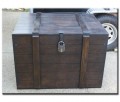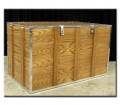Designer: John Nevil Maskelyne
Maskelyne developed the trunk in the mid-1800s, but did not perform it using a switch. Ken Silverman (author of Houdini! (1996)) claimed that Maskelyne presented a version in England as early as 1865 to prove that he could outdo the Davenport Brothers. He would curl inside a small wooden box. The box was then locked and covered with a canvas and laced. Maskelyne would then escape.
Houdini also used the effect in the early 1900s, but modified the routine to include a switch between assistant and performer and subsequently the effect became known as "Metamorphosis." Houdini had a series of helpers hold feather fans in place, effectively blocking the audience's view of the trunk for the switch to occur. The "trick" was that the switch was very fast and seemingly impossible, even with the cover.
Modern version - The magician is locked in a trunk (he may be shackled and placed in a bag as well as there are countless variations). The assistant then raises a drape around the trunk and stands to the side or on top. The assistant raises the drape and then drops it quickly, revealing she has turned into the magician. The trunk is opened and the assistant is found inside.
Notable variations include performing the effect with a water-filled trunk (Mark Wilson), performing underwater (Penn & Teller), and using a flash of fire as the "cover" (Criss Angel).
Other notable performances would include the Pendragons, who are widely known for doing the effect the fastest - truly looking instantaneous.
The trunk itself has varied from packing crates, to standard trunks, to clear trunks. Metamorphosis is one of the most-often performed illusions in magic.
Photo Credit: Rich Hill


